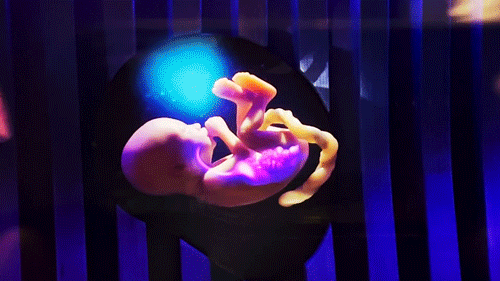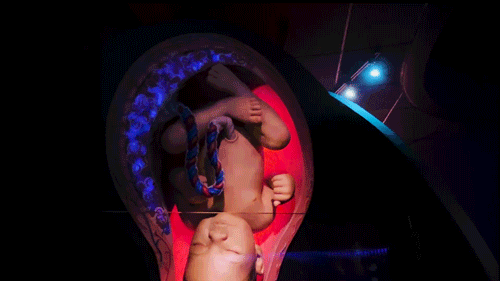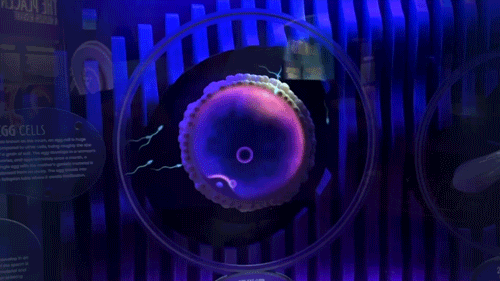
The Mission of the Fearfully and Wonderfully Made Exhibit
Lives Changed and Hope Restored
Tell Your Story Testimonies FAQ
The Fearfully & Wonderfully Made exhibit at the Creation Museum stands as a testimony to the wonder and sanctity of all human life. The Bible informs us that every human being, both male and female and from the moment of fertilization, is made in God’s image. This is true regardless of one’s level of development, physical or mental ability, ethnicity, or age. Although issues regarding life in the womb are hotly contested in our world, the matter is settled by the ultimate authority, the very words of our Creator.
The Fearfully & Wonderfully Made Exhibit calls attention to biblical and scientific truths about the unborn while pointing guests to the hope and forgiveness that can only be found in the gospel of Jesus Christ.
Download Exhibit Booklet (PDF)
Pro-life Pregnancy Resource Centers
Call Heartbeat International Option Line 1-800-712-HELP, text “HELPLINE” to 313131, or visit Heartbeat International or Care Net.
Post-Abortion Resource
Tell Your Story
Testimonies
Stories of Belonging
I was adopted by a Christian family, even though they had only seen pictures of me, and they had three children of their own. My new family loved and accepted me. They taught me the truth of Scripture and shared the gospel. Eventually, I surrendered my life to Christ.
Through adoption, I realized, “I’m chosen.” As an adult, I visited my biological family, and I came to understand that God ordained my adoption. He protected and provided for me through my adoptive family.
—Frances
My husband and I were heartbroken when we discovered we would not be able to have biological children. But God turned our mourning into joy when He opened the door for us to adopt a beautiful baby girl from China. Our daughter has brought us laughter, adventure, and the privilege of seeing a young person love God and live for Him. We also have the distinct privilege of living out an earthly example of a profound spiritual truth: God’s adoption of us as His children when we receive Christ as our Savior.
—Georgia
Stories of Forgiveness
I reasoned that my only option was abortion. No one informed me how incredibly dark that abortion experience would be, and how it would literally eat away at my soul. God finally stopped my downward spiral of self-destruction and showed me that He wanted me to have a close personal relationship with Him. Through a Bible study written by someone who had had an abortion, someone who had been in my shoes, I found the answers I had been searching for my whole life. I had a fresh desire to know the God who created me and had a plan for my life.
—Camille
I never wanted children. I made up my mind. I drove Sandy to an abortion clinic and dropped her off. That day, a part of us died. Later, she confessed waiting for me to burst through the door of that abortion clinic and save her and my baby, but I didn’t. I was a coward. I feared man, but not God. God began to work on my heart. Once I grasped the depth of my sin, looking at what Christ had done on the Cross, it came into full view in my mind that my sin had been fully dealt with and I could fully live in repentance and faith. God did a thorough work in my heart, my life, and my marriage.
—Chad
Stories of Hope
We excitedly announced our pregnancy when we were about seven weeks along. But at our ten-week appointment we were deeply saddened to find out we lost our baby. We still have moments of great sadness, grieving what could have been.
We are thankful for how the church loved and rallied around us. God is good and is the God of all comfort, and we’ve learned to count it all joy knowing that what seems hard He will redeem for good.
—Paige
My husband and I endured three miscarriages in about a year, and it’s been difficult to express my tremendous sense of loss. Even my husband said that it took a while for him to understand the depth of my grief, but he has been extremely supportive ever since. One of our greatest comforts came from having a biblical worldview. Knowing that all death and sorrow was a result of Adam’s sin rather than being part of God’s original creation helped me work through our emotions with hope, trust, and even joy. Indeed, Jesus Christ is our living hope!
—Heather
Frequently Asked Questions
Why would you put real babies on display?
We did not put real babies on display. Our “babies” are lifelike models made by our very talented design team. Each “baby” has an identification sign in front of it reminding guests that these are models.
Some guests might be disturbed by some of the early-stage models. Why would you sculpt such models?
Our goal in sculpting these models was to show what human life looks like at these various stages of development in the womb. The models are not intended to be disturbing or gruesome in any way. However, at some of the early stages, a baby does not look like a fully developed human child, and the translucent skin allows many of the organs, blood vessels, and other features to be seen. Again, the goal here is realism rather than some sort of shock value or disturbing imagery.
With all your emphasis on every person being of one blood, why did you choose to sculpt a Caucasian baby?
The Creation Museum certainly emphasizes the biblical truth that all people are descended from Adam and Eve, and later, from Noah and his wife. Thus, there truly is only one human race. We did not sculpt a Caucasian baby. The baby models on display were digitally sculpted by our 3D artist who used a variety of references, although most of them had Asian or South American parentage. Careful examination of the “older” models will bear this out. For example, the head shape of babies with European ancestry tends to be narrower and longer compared to Hispanic and Asian babies, which tend to be rounder. Also, the eyelids of babies considered to be Caucasian tend to be thinner than babies whose heritage is from Asia or South America. Our models exhibit features consistent with babies from Asia or South America. Based on the skin shade of the full-term model, one might think of the baby as Caucasian. However, even this feature is based on babies with Asian or South American parentage. Many newborn babies are typically somewhat pink, and even those who will eventually have darker skin are a lighter shade when they are born. The skin next to their fingernails and toenails, as well as on the top of their ears is generally darker and indicative of the shade their skin will become in the months that follow.
Why is the Creation Museum getting into a political debate?
The Creation Museum is not focused on political matters. However, nearly every important subject will overlap with political matters at some point. The biblical worldview encompasses who we are as human beings and shapes our values, which in turn informs our political views. However, politics is certainly not the focus of this exhibit, as is demonstrated by the fact that we do not really address abortion until the final section of the exhibit. Our emphasis is to celebrate the wonder of human life and to stress that every single human being, from the moment of fertilization, is made in the image of God.
These scientific and theological truths are a vital part of the biblical worldview. But the naturalistic, evolutionary worldview denies these truths. Yes, those who come from this perspective can acknowledge the complexity and wonder of human development in the womb, though they attribute it to blind-chance processes that developed over millions of years. Furthermore, they have no basis for placing inherent value on human life, so the child in the womb is often considered to be just a clump of cells with no more value than a rock, a piece of grass, or a drop of water. But from the biblical creation worldview, all human life is precious because we are all made in the image of our Creator.
Aren’t you concerned about upsetting women who have had abortions?
We took great care in developing this exhibit to be sensitive toward people who have been involved in making the decision to abort a child. It is not our goal to be combative, but we also do not shy away from speaking the truth in love. By highlighting biblical teaching about the unborn and showing their amazing development in the womb, we aim to persuade people that abortion is wrong before we even get into the topic. And if someone is upset by the exhibit because of their decision to seek an abortion, we pray that the Holy Spirit will bring about conviction in that person’s life and that they will seek the forgiveness and healing that can only be found in the gospel of Jesus Christ.
Aren’t you concerned about upsetting women who have suffered miscarriages?
We took great care to be sensitive toward those who have suffered loss of a child during pregnancy. Before any part of the exhibit was written or designed, our content manager and exhibit designer took part in numerous meetings with women as they sought to develop the proper approach from both the content and design perspectives. We realized that the exhibit would likely be visited by more women who had lost a child through miscarriage than those who have sought abortions. So, we added a large sign addressing what happens to a baby who dies. God is love (1 John 4:8), and these individuals need his comfort and the hope that they can see their child someday. While the Bible does not directly address what happens to young children who die, there are several passages that seem to imply they will be with the Lord. Like Abraham, all Christians can take comfort in the belief that our Creator, the Judge of all the earth, will do what is right (Genesis 18:25).
Why weren’t you more aggressive in attacking abortion? Why not show aborted babies?
Some people believe that the most effective way to debate this topic is by showing people the stark reality of abortion. Perhaps you’ve seen people hold up signs with pictures of aborted babies, and it is certainly possible that someone will truly see the horrors of abortion through such a practice. But we do not believe that is the only effective strategy to change hearts and minds on this topic, particularly in an exhibit at the Creation Museum where families with young children are often present. As mentioned earlier, the focus of this exhibit is the celebration of human life made in the image of God, especially of those in the womb. It is not primarily an exhibit against abortion. Yet, by stressing the value of human life and showing little babies in the womb through ultrasound videos and spectacular models, we believe our approach will be persuasive in helping people understand why abortion is so terrible and a sin against a holy God.
How did you choose which models to sculpt? Why not just sculpt nine so that you could have one per each month of pregnancy?
Instead of choosing to sculpt nine models, one for each month, we decided to sculpt twelve. The age at which each model is shown was chosen because of the features that are developing at that time, particularly those features that people often identify with personhood. For example, we have one model at the age when the heart begins to beat and another model corresponding to the age when fingerprints appear.
Why didn’t you use familiar terminology like trimester and viability?
We decided to avoid using terms like these because some people use them as arbitrary points before which it is okay to abort a child. For example, some states outlaw abortions during the third trimester. While we are grateful for the number of lives saved by such laws, we recognize that this date is arbitrary and still ends the life of a child. Many babies born prior to this date have survived, and there is nothing critical that happens in the child’s development at the end of the second trimester and start of the third that should cause a person to think of the baby as suddenly becoming human at that point. Similarly, the fact that a 10-week old baby in the womb cannot survive outside the womb (i.e. is not “viable”) does not mean that the child is less than human or that abortion should be acceptable at this age. We wanted to avoid any association with arbitrary ideas like this.
Why didn’t you use the gestational age of the baby, which is what most people are familiar with since it is the standard when referring to the timing of one’s pregnancy?
We chose to emphasize the embryonic age of the child, which starts from the moment of fertilization. The traditional gestational age is based on the date of the mother’s last menstruation and yields an age approximately two weeks older than the baby’s actual age. We explain this in more detail in the exhibit, and to reinforce our teaching about embryonic age, each of our 12 models includes a label stating the actual age the model represents, such as “40 Days of Life” and “11 Weeks of Life.”
How did you select the various biblical passages discussing babies in the womb? It seems like you missed a couple of popular verses like Jeremiah 1:5 and Isaiah 44:2.
The verses used in the biblical relevance section were selected based on their relevance to the topic at hand. These verses reveal the value and personhood of the unborn child.
Although it is often cited in relation to these topics, Jeremiah 1:5 does not quite make the same point we are making.
Before I formed you in the womb I knew you;
Before you were born I sanctified you;
I ordained you a prophet to the nations. (Jeremiah 1:5)
God stated that He knew Jeremiah before He formed the prophet in the womb. While it is true that Jeremiah was a person in the womb, this verse is stressing God’s omniscience, illustrated by the fact that God knew the prophet before Jeremiah even existed. If we were to apply this verse to the personhood of Jeremiah, we would need to conclude that he existed as a person prior to fertilization, a concept we do not agree with. Thus, this verse is not directly teaching about Jeremiah’s personhood in the womb.
Meanwhile, Isaiah 44:2 is very clearly about the nation of Israel and not an individual child in the womb of his or her mother.
Yet hear me now, O Jacob My servant, and Israel whom I have chosen.
Thus says the Lord who made you and formed you from the womb, who will help you:
“Fear not, O Jacob My servant;
And you, Jeshurun, whom I have chosen.” (Isaiah 44:1–2)
It is true that both of these passages demonstrate that the Bible uses the womb as a metaphor to speak of the beginning of something. Thus, the verses are certainly consistent with what we are teaching and could be used in that way.
What Bible version did you use?
As with the exhibits at the Ark Encounter and recent exhibits at the Creation Museum, we used our own wording based on several leading translations. The reason for this approach is that nearly all Bibles require copyright statements to be included whenever they are cited. So instead of having a long copyright statement on each sign, we used our own wording consistent with the most respected translations.
I heard the heartbeat sound in the exhibit’s score, but it did not match the rate of baby’s heartbeat in the womb. Why not use something that accurately reflects what takes place in the womb?
The normal heart rate of a baby in the womb changes throughout development. It is true that for most of the pregnancy, the baby’s heart rate is about twice as fast as an adult’s resting heart rate. However, the score in Fearfully & Wonderfully Made was composed to help create a calming and peaceful environment in the exhibit while utilizing the sound of a heartbeat, which is an obvious sign of life. The score was not intended to make a teaching point about the baby’s heart rate.

Answers in Genesis is an apologetics ministry, dedicated to helping Christians defend their faith and proclaim the good news of Jesus Christ.
- Customer Service 800.778.3390
- Available Monday–Friday | 9 AM–5 PM ET
- © 2026 Answers in Genesis







